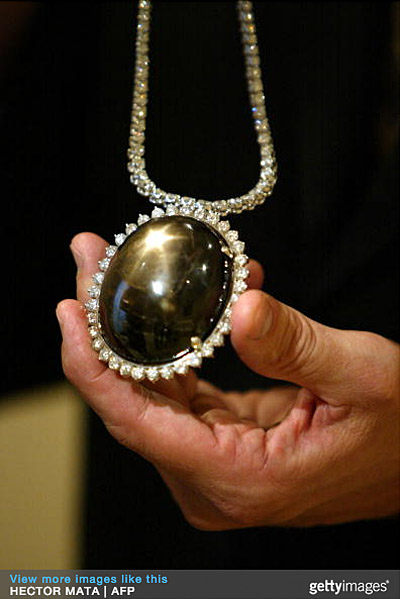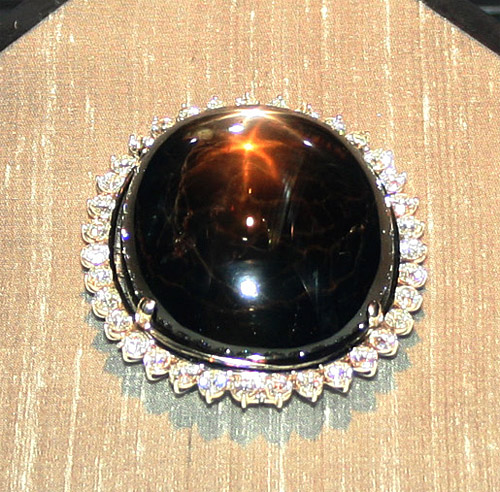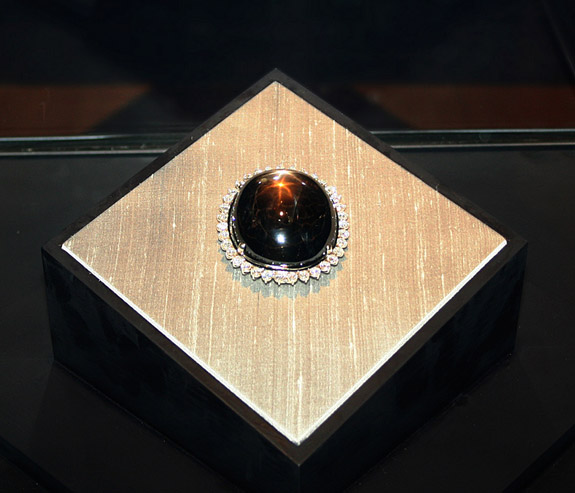Blog Archive
-
2015
(146)
- October(2)
-
September(14)
- Stunning 16.08-Carat Fancy Vivid Pink Diamond Coul...
- Colossal Natural Pearl Poised to Break World Recor...
- Music Friday: You're Shining Like a Brand New Diam...
- Flawless Blue Moon Diamond Expected to Break Two P...
- Music Friday: Peggy Lee Wants a 'Ring, Ringa-Linga...
- Giant Air Purification Tower Helps Turn Smog Parti...
- Music Friday: Michelle Pfeiffer Is White Gold in B...
- Ring Selfie Ends Speculation About Who Will Be Sin...
- The Hope Spinel — the Less Famous Cousin of the Ho...
- 'A Heritage in Bloom' Necklace Features 24 Flawles...
- Music Friday: Carly Simon Fights With Her Sisters ...
- Soaking Wet and Smelling Like a Fish, This Romeo G...
- World's Largest Gem-Quality Star Sapphire Served a...
- Famous Cowdray Pearls Return to Sotheby's After 78...
- August(13)
- July(19)
- June(12)
- May(23)
- April(22)
- March(19)
- February(18)
- January(4)
About Me
- Unknown
Powered by Blogger.
Blog Archive
-
▼
2015
(146)
-
▼
September
(14)
- Stunning 16.08-Carat Fancy Vivid Pink Diamond Coul...
- Colossal Natural Pearl Poised to Break World Recor...
- Music Friday: You're Shining Like a Brand New Diam...
- Flawless Blue Moon Diamond Expected to Break Two P...
- Music Friday: Peggy Lee Wants a 'Ring, Ringa-Linga...
- Giant Air Purification Tower Helps Turn Smog Parti...
- Music Friday: Michelle Pfeiffer Is White Gold in B...
- Ring Selfie Ends Speculation About Who Will Be Sin...
- The Hope Spinel — the Less Famous Cousin of the Ho...
- 'A Heritage in Bloom' Necklace Features 24 Flawles...
- Music Friday: Carly Simon Fights With Her Sisters ...
- Soaking Wet and Smelling Like a Fish, This Romeo G...
- World's Largest Gem-Quality Star Sapphire Served a...
- Famous Cowdray Pearls Return to Sotheby's After 78...
-
▼
September
(14)
Wednesday, 2 September 2015
 World's Largest Gem-Quality Star Sapphire Served as a Dusty Doorstop for Nine Years
World's Largest Gem-Quality Star Sapphire Served as a Dusty Doorstop for Nine Years
SEPTEMBER 2ND, 2015
As a tribute to all of our readers lucky enough to be born in September and have sapphire as their official birthstone, we'd like to share the amazing rags-to-riches story behind the world's largest gem-quality star sapphire — the 733-carat Black Star of Queensland.

It was 1938 when a 12-year-old Aussie boy named Roy Spencer plucked an unusual grey stone from a nearby hillside and bolted home to show his dad. Harry Spencer, a struggling miner who lived in a dusty shack with his family in Queensland, identified his son's half-pound stone as a large black crystal and relegated it to the back door, where it served as a doorstop for nine years.
But this would turn out to be no ordinary crystal.
Nine years later, the famed Los Angeles-based Kazanjian brothers were traveling around the world sourcing gemstones for their thriving jewelry business when they visited the Spencer family. Harry Kazanjian spied a pile of black stones that he suspected might be star sapphires. When Harry Spencer saw the Kazanjians' interest in the black stones, he told his son, now 21, to fetch the doorstop.

Kazanjian noticed that the 1,156-carat, fist-sized stone glimmered with a hint of copper color, a sign of the impurity that creates the appearance of a star in a star sapphire. In the gemological world, the optical effect is known as asterism. Kazanjian reportedly purchased the stone for $18,000 (about $196,000 in today's dollars).
Kazanjian took the stone back to his studio in Los Angeles and studied it for months before embarking on the risky cutting and polishing process. One false calculation could ruin the star effect and much of the stone's value.
"I could have ruined it a hundred times during the cutting," Kazanjian had told a Los Angeles Times reporter at the time.

The jeweler meticulously carved a dome in the oval stone to reveal a distinct six-pronged star. More than 400 carats were sacrificed in the cutting process. When completed, the Black Star of Queensland weighed 733 carats and was about the size of a hen's egg. The Kazanjians emphatically announced that the stone — despite a valuation of $1 million ($9.7 million today) — was not for sale.
Even though it had earned the undisputed title of the "world's largest gem-quality star sapphire," the Black Star of Queensland spent most of the 1950s in relative obscurity. That all changed in the 1960s, when it joined the Hope Diamond in the Smithsonian.

In 1971, Cher wore the sapphire during a sketch for the popular Sonny & Cher Comedy Hour. In the skit, she's dripping with precious gems while being protected by security guards. The running joke is that the guards won't let Sonny near Cher while he sings The Carpenters' 1970 hit, "Close to You."
For the taping, the sapphire had been affixed to a diamond necklace with a flimsy wire. Michael Kazanjian, the nephew of Harry, started to panic as Cher went through many takes of her dance number. Fearing the stone would fall off and shatter, he jumped up on the stage rescued the stone. Apparently, CBS got the take that they wanted because a still from the show clearly shows Cher wearing the Black Star of Queensland.

The Black Star of Queensland's most recent public appearance was in 2007, when it enjoyed a six-month run at the Royal Ontario Museum.
The gem, which is currently set with a halo of 35 white diamonds, is owned by an anonymous private party. The extraordinary example of September's birthstone is reportedly worth upwards of $80 million.
Photos: Getty Images; Greyloch, via Wikimedia Commons; CBS.

It was 1938 when a 12-year-old Aussie boy named Roy Spencer plucked an unusual grey stone from a nearby hillside and bolted home to show his dad. Harry Spencer, a struggling miner who lived in a dusty shack with his family in Queensland, identified his son's half-pound stone as a large black crystal and relegated it to the back door, where it served as a doorstop for nine years.
But this would turn out to be no ordinary crystal.
Nine years later, the famed Los Angeles-based Kazanjian brothers were traveling around the world sourcing gemstones for their thriving jewelry business when they visited the Spencer family. Harry Kazanjian spied a pile of black stones that he suspected might be star sapphires. When Harry Spencer saw the Kazanjians' interest in the black stones, he told his son, now 21, to fetch the doorstop.

Kazanjian noticed that the 1,156-carat, fist-sized stone glimmered with a hint of copper color, a sign of the impurity that creates the appearance of a star in a star sapphire. In the gemological world, the optical effect is known as asterism. Kazanjian reportedly purchased the stone for $18,000 (about $196,000 in today's dollars).
Kazanjian took the stone back to his studio in Los Angeles and studied it for months before embarking on the risky cutting and polishing process. One false calculation could ruin the star effect and much of the stone's value.
"I could have ruined it a hundred times during the cutting," Kazanjian had told a Los Angeles Times reporter at the time.

The jeweler meticulously carved a dome in the oval stone to reveal a distinct six-pronged star. More than 400 carats were sacrificed in the cutting process. When completed, the Black Star of Queensland weighed 733 carats and was about the size of a hen's egg. The Kazanjians emphatically announced that the stone — despite a valuation of $1 million ($9.7 million today) — was not for sale.
Even though it had earned the undisputed title of the "world's largest gem-quality star sapphire," the Black Star of Queensland spent most of the 1950s in relative obscurity. That all changed in the 1960s, when it joined the Hope Diamond in the Smithsonian.

In 1971, Cher wore the sapphire during a sketch for the popular Sonny & Cher Comedy Hour. In the skit, she's dripping with precious gems while being protected by security guards. The running joke is that the guards won't let Sonny near Cher while he sings The Carpenters' 1970 hit, "Close to You."
For the taping, the sapphire had been affixed to a diamond necklace with a flimsy wire. Michael Kazanjian, the nephew of Harry, started to panic as Cher went through many takes of her dance number. Fearing the stone would fall off and shatter, he jumped up on the stage rescued the stone. Apparently, CBS got the take that they wanted because a still from the show clearly shows Cher wearing the Black Star of Queensland.

The Black Star of Queensland's most recent public appearance was in 2007, when it enjoyed a six-month run at the Royal Ontario Museum.
The gem, which is currently set with a halo of 35 white diamonds, is owned by an anonymous private party. The extraordinary example of September's birthstone is reportedly worth upwards of $80 million.
Photos: Getty Images; Greyloch, via Wikimedia Commons; CBS.
Subscribe to:
Post Comments (Atom)
0 comments:
Post a Comment